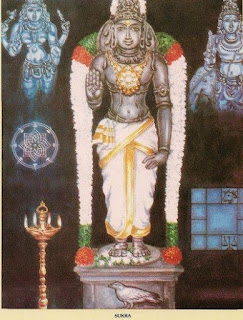Sri Kshetra (Darukona cave)
The “Madala Panji”, the oldest document maintained by the servitors and astrologers of Puri Jagannath temple, has the description of this incident. Muslim invaders like Raktabahu and Kalapahada were fond of attacking Hindu temples of the country. While he was planning to attack the Puri Jagannath Temple. It was Lord Jagannath who came in the dream of the king of Puri and gave him the idea of hiding him along with Lord Balabhadra and Subhadra maa, to avoid the mishap.
Following the omen, The king with the help of others started shifting the deities in the opposite direction of the Mahanadi river. The group of Servitors reached Sonepur with the help of Sonepur King, where they took the deities to a nearby hill which is now known as “Patali Srikhetra”. It is said that many miraculous events were witnessed by the group while shifting the deities. A few incidents happened where Snakes and Tigers helped them to reach an accurate location.
The incident is described in the folklore of Nakdega, a nearby village of Kotsamlai. It goes like this: “during that time the area used to be a dense forest and the chances of getting lost were very high. The group while shifting the lords got lost in the forest and couldn’t find their way to the destination. Suddenly a snake appeared and led the road to the hill”. The place where the incident took place got the name “Sapdein". The whole journey was full of such incidents. It is said that mother nature in Sonepur was also helping the group by sending elephants when the group used to get lost.
Another such incident was beautifully narrated by the villagers. “The team from Puri after reaching Sonepur by boats started moving towards the hill. After crossing the river Mahanadi, the team lost their way. They got stuck near a village. On that night they saw some bright lights coming from the hills. The next morning they proceeded in that way and found the destination. Later on, the village got the name of Jagannathpali. After reaching the hill near Patali, the king with his followers searched for a private place for the deities and constructed a throne. The wooden deities were established on the throne and worshipped for 49 years in privacy. After 49 years when the chances of foreign invasions got revived the deities were buried inside a cave which was situated in a corner of the hill and it was sealed from outside with the help of soil.
They then planted a tree in front of the cave as a symbol or mark to find the deities. The cave is now known as “Darukona Cave”. The etymological meaning of “Daru” is a tree and “Kona” is a corner. Time passed by and so did the rulers. After king Shovan Dev, Subarna Dev, and Chandra Dev became kings but they never tried to restore the lost deities of Puri Jagannath temple. They were busy fighting with the foreign Invaders. The abode of Lord Jagannath remained empty in Puri. When Jajati Keshari became the ruler, he got to know from the elders of the state that the deities were taken to a place called Sonepur. He marched an expedition and started searching and inquiring about the lost wooden deities. By then 144 years had passed. The King got the information that the deities were there in “Patali Srikhetra” in Sonepur.
Many saints and Jajati Keshari himself with the Shankaracharya of puri came to Sonepur and searched for the deities. They did an inquiry and came to know that the locals near the Kotsamalai village were worshipping a huge tree on the hills as God. After cutting the tree and digging the area, they found the ancient wooden deities buried inside the cave in a bad condition. According to the “Madala Panji”, they chose the riverway to return and the Sonepur King arranged boats for the transportation of deities. Locals of Puri used to call those boats “Koshali Danga”. King Jajati Keshari constructed new deities as the old ones were in bad condition. He also constructed a new temple measuring 38 arms in height for the deities. He sent one of his ministers to Nepal to bring the “Shaligram” from the Gandaki river. The Shaligrams were then consecrated and placed inside the deities. Since then a new ritual called “Nabakalebara” started in Puri and the king Gajapati Jajati Keshari came to be known as the second “Indradyumna”. The temple got its deities back after a long 144 years.
Jagannath Temple was invaded 18 times. The first Muslim invasion on it was waged by Illlias Shah, the Sultan of Bengal, in 1340. Firuz Shah demolished the temple of Jagannath and desecrated the images around 1360. Sultan Husain Shah of Bengal captured Puri in 1509 and destroyed the deities in Jaganath Temple. The fifteenth invasion was waged by Amir Fateh Khan in 1647. Every such raid resulted in destruction, loot, and damage to the deities of Puri. During various attacks, the deities were hidden at distant places or shifted from one place to another.
I hope now you have a valid reason for not blaming the servitors and temple Administration for not allowing non-Hindus inside Temple.




Comments
Post a Comment